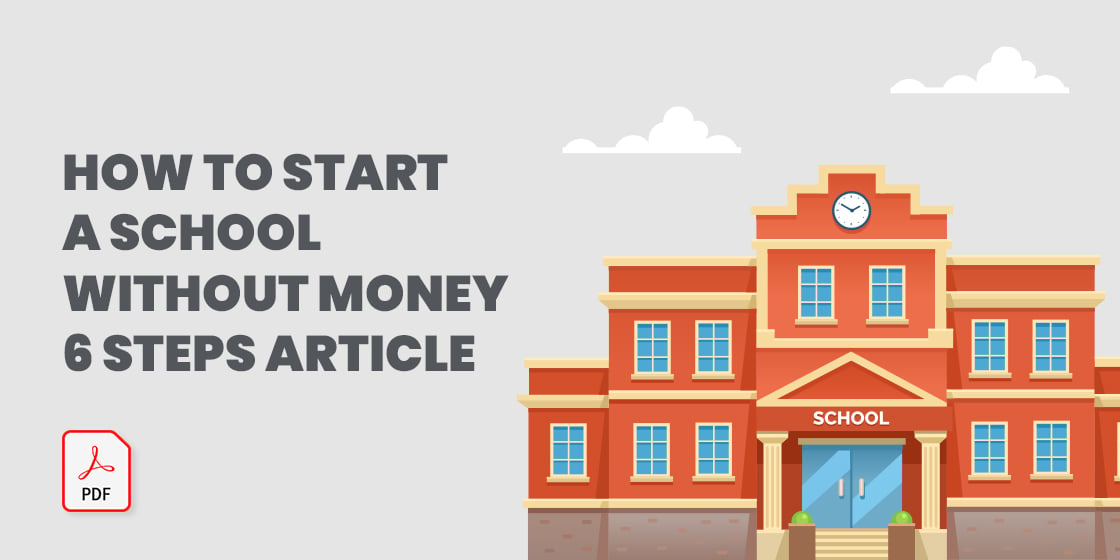
How to Write a Business Plan for Starting a School – 6 Steps
Every kind of business, regardless of its size, needs thorough planning to ensure success in the long run. According to…
Feb 24, 2023
Without a doubt, you need to gather enough assets and capital in starting a school. Right now, you might be thinking about how much money you need to take from your bank account to start your school. Well, ease your mind for a bit. What if we say that you can start a school without taking money from your pocket, would you believe us? Well, you should. It’s very feasible to launch your own educational establishment without taking it from your wallet. In this blog, we’ll show you six steps in starting your private school without spending your own money.

Starting an educational establishment follows the same principle as starting any kind of business. That said, your first step should be formulating a business plan. Your business plan must contain everything that you want and need for your school. Basically, it’s a roadmap in making your vision in establishing a school premise a reality.
The contents of your school business plan should include an executive summary, a description of your school, a workforce structure, a budget plan, a market analysis, an objectives school checklist, and marketing strategies. Creating a business plan for a school is definitely challenging. You need to consider and assess many factors in launching a school without using your own money. But, it’s part of the process. And as an educational entrepreneur, you have to understand that. Plus, don’t put too much pressure on yourself in devising your business plan. As you execute your business strategies, you’ll get some help from other people along the way.
There’s one thing you must include in your business plan as well, which is to state whether your school will be a profit or nonprofit establishment. You may have decided between profit or nonprofit already, but know that each of the two has different effects on your school’s business structure.
If you choose your school to be a profit establishment, you (the owner) will oversee it as the sole proprietor. You also have the option to get a business partner and ask them to finance the school’s needs. As a matter of fact, getting a partner would be a better option. Why? Well, that’s because you’re trying to launch your school without using your money. It’ll be near impossible to do that without a business partner. Or, you can try to register your school as a limited liability company (LLC).
On the other hand, if you opt for your school to be a nonprofit Business establishment, it’ll be supervised by a board of directors. And, you’ll need to get a 501 (c)(3) nonprofit status from the Internal Revenue Service (IRS). A 501 (c)(3) nonprofit status will exempt your nonprofit school from paying taxes. The IRS grants charitable, religious, and educational organizations federal tax exemptions. So, take full advantage of that exemption if your school will be a nonprofit establishment.
Do you own a land property, a building, computer sets, or anything that can help you start a business? If you do, know that those are your tangible assets, and you can utilize them to start your school. In the case of launching a business without money, you have to use tangible assets as your capital. If you’re not using them for any profitable or meaningful purpose template, use them for business. Resourcefulness is key to building a well-structured business without using your own financial assets.
You need funding from other people if you’re to establish a school without using money from your pocket. To get fundings for your school, you might need to create a School proposal and present it to prospective investors. In general, your proposal must explain how the school will benefit the community. In that way, the investors will see that your school has a clear purpose and objective. A solid and well-written proposal will certainly encourage investors to fund your school’s necessities. Moreover, if you can provide details on how the investors will benefit from your school, that will could help your case furthermore.
When you meet with investors, you should record your every agreement with them in a School meeting minutes document. It clears things up regarding the terms and conditions of their investment for your school.
According to a study stated in ProfitableVenture.com, starting a small-scale private school requires a capital of $300,000 to $500,000. Of course, you have to start your school small. Starting it as big as a state high school plan isn’t a practical business move. So, you should try to obtain investments amounting between $300,000 to $500,000 or more.
In starting a school business without using your money, you need to minimize costs as much as possible. Wages for your school’s teachers will be among your most expensive costs. With that in mind, you should hire teachers who are willing to accept the minimum wage for the meantime. Look for teachers who can understand that your school is a startup business and hasn’t achieved a steady revenue yet.
In this matter, it’s best to hire passionate teachers who are fresh graduates. Most likely, they’ll be willing to accept a minimum wage payment because they don’t have enough experience yet, and they might like the idea of being a pioneering educator in a new school. You can increase the wages of your teachers when your school gains enough revenue from School quotations or tuition fees. Once you find teachers who are open to accepting minimum payment, offer them a School contract as soon as you can.
When your basic school has everything it needs to operate, you should inform your state’s educational division 2-3 months before openings its doors. That’s a mandatory step for every school that’s about to launch.
After informing the educational division, you need to apply your school for accreditation from authorized and reputable educational agencies. They’ll conduct a thorough school assessment of whether facilities and programs comply with general educational standards. It sounds intimidating, but you’ll have nothing to worry about if you’ll follow proper guidelines in building your school. Once your school earns accreditation, it can start accepting enrollments soon. Getting accreditation will cost money, but your investors will cover for it mostly.
Not having enough money in your account isn’t a hindrance from pursuing your dream of establishing a school for the youth. Your dream of building a school is a noble cause. Many will come rushing to your aid once they know about your plan. Your school will soon provide opportunities for the youth of your community.

Every kind of business, regardless of its size, needs thorough planning to ensure success in the long run. According to…

Most people often think that the target customers of your private school are students. Well, they’re right. But, your private…

The faculty staff is the backbone of your private school. Without them, your campus wouldn’t be able to operate and…

If you’re planning to increase your school’s student enrollment, improving the education quality it delivers is an excellent way to…

Student enrollment is what enables your private school to gain revenue and profit. When you were still in the phase…

Without a doubt, you need to gather enough assets and capital in starting a school. Right now, you might be…